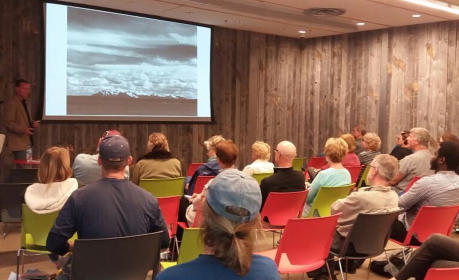John
Clayton
is
very
talented
writer,
who,
as
said
in
one
review
on
his
book?
“explores
the
vast
historical
and
cultural
history
of
one
of
the
most
popular
national
parks
to
uncover
why
Yellowstone
is
so
beloved
in
"Wonderlandscape:
Yellowstone
National Park and the Evolution of an American Cultural Icon."”
JBN:
What
are
you
reading
right
now?
Are
there
any
authors
(living
or
dead)
that
you
would
name as influences?
John
Clayton:
Researching
my
next
book,
I
am
now
reading
several
academic
texts
about
the
evolution
of
environmental
policy.
For
pleasure,
I’ve
recently
read
books
by
Montana
authors,
including
Anne
Helen
Petersen’s
Too
Fat,
Too
Slutty,
Too
Loud,
about
celebrity
feminism,
and
David
Abrams’
Brave
Deeds,
a
novel
of
the
Iraq
War.
My
influences
include
“literary
journalists”
such
as
J.
Anthony
Lukas
(Common
Ground,
Big
Trouble),
Tracy
Kidder
(House,
Soul
of
a
New
Machine),
and
Michael
Lewis
(The
Big
Short,
Moneyball)
as
well
as
pop-culture
writers
such
as
Chuck
Klosterman
(Sex,
Drugs,
and
Cocoa
Puffs),
historians
such
as
William
Cronon
(Nature’s
Metropolis),
and
nature
writers
such
as
Gary
Ferguson
(The
Carry Home, Land on Fire).
JBN:
Please
tell
more
about
your
new
book
Wonderlandscape:
Yellowstone
National
Park
and
the
Evolution
of
an
American
Cultural
Icon.
How
came
idea
to
write
about
it?
Why
Yellowstone
park?
What
you
mean
when
you
speak
about Evolution
of
an
American
Cultural Icon?
John
Clayton:
Wonderlandscape
focuses
on
why
Yellowstone
is
famous
and
how
that
has
changed
over
the
years.
I
wrote
the
book
because
I
realized
that
people
around
the
world
have
heard
of
Yellowstone,
and
think
they
know
it.
It’s
famous
in
a
way
that
Montana
or
Glacier
National
Park
or
other
special
places
aren’t
famous.
I
wanted
to
understand why.
I
have
an
unusual
way
of
looking
at
the
history
of
Yellowstone:
it’s
the
history
of
what
people
want
from
Yellowstone.
Yellowstone’s
diverse
wonders
continually
meet
our
nation’s
changing
needs:
half-tame
wildlife,
rugged
frontier,
unpeopled
wilderness,
etc.
The
book
is
called
Wonderlandscape
because
Yellowstone
was
originally
nicknamed
“Wonderland”
(it
came
to
prominence
just
a
few
years
after
Lewis
Carroll’s
Alice
in
Wonderland)
yet
public
perceptions
of
Yellowstone
have
evolved
from
a
geological
freakshow to a rich landscape.
JBN:
How long you worked on this book?
John
Clayton:
Six
years
ago
I
decided
to
write
a
book
about
Yellowstone.
It
took
me
two
years of research before I developed the core idea of Wonderlandscape.
JBN:
Who helped you to do most of your research job?
John
Clayton:
I
did
all
the
research
myself!
I
benefitted
from
a
weeklong
fellowship
from
the
Buffalo
Bill
Center
of
the
West,
in
Cody,
to
study
their
archives
of
the
1988
fires.
I
also
spent
several
days
at
the
Park
archives,
in
Gardiner.
Many
other
libraries
and
archives
played
smaller
roles
in
my
research.
Yay libraries!
JBN:
Do you have now in mind to write something else?
John
Clayton:
Yes,
I
am
working
on
a
book
about
the
early
interactions
of
John
Muir
and
Gifford
Pinchot.
Muir,
defender
of
Yosemite
National
Park
and
co-
founder
of
the
Sierra
Club,
is
often
seen
as
philosophically
opposed
to
Pinchot,
founder
of
the
U.S.
Forest
Service
and
advocate
of
“multiple
use.”
But
their
early
collaborations
are
epitomized
by
a
delightful
camping
trip
they
took
in
(what was not yet established as) Glacier National Park in 1896.
JBN:
You
write
mostly
about
Montana,
in
books
described
at
www.johnclaytonbooks.com. Describe this state in few sentence please
John Clayton:
Gosh, if I could do that, I wouldn’t have to write all these books!
To be continued…




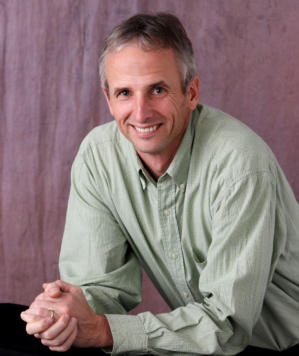
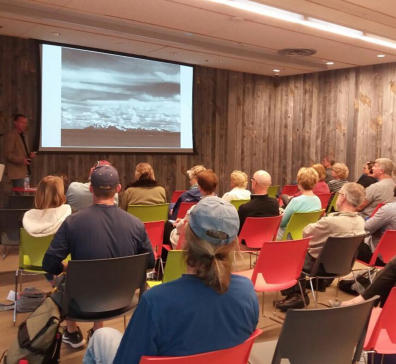
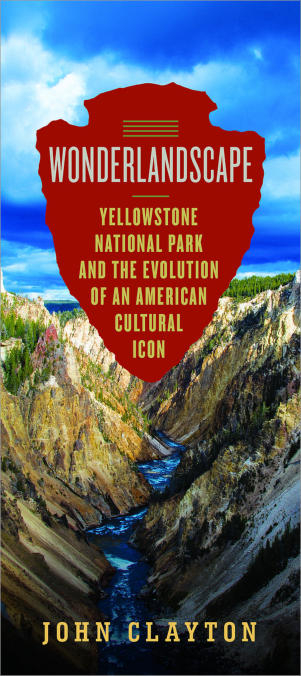
John Clayton: Wonderlandscape focuses on why Yellowstone is
famous and how that has changed over the years.
John Clayton
John
Clayton
is
very
talented
writer,
who,
as
said
in
one
review
on
his
book?
“explores
the
vast
historical
and
cultural
history
of
one
of
the
most
popular
national
parks
to
uncover
why
Yellowstone
is
so
beloved
in
"
W
o
n
d
e
r
l
a
n
d
s
c
a
p
e
:
Yellowstone
National
Park
and
the
Evolution
of
an
American
Cultural Icon."”
JBN:
What
are
you
reading
right
now?
Are
there
any
authors
(living
or
dead)
that
you
would
name as influences?
John
Clayton:
Researching
my
next
book,
I
am
now
reading
several
academic
texts
about
the
evolution
of
environmental
policy.
For
pleasure,
I’ve
recently
read
books
by
Montana
authors,
including
Anne
Helen
Petersen’s
Too
Fat,
Too
Slutty,
Too
Loud,
about
celebrity
feminism,
and
David
Abrams’
Brave
Deeds,
a
novel
of
the
Iraq
War.
My
influences
include
“literary
journalists”
such
as
J.
Anthony
Lukas
(Common
Ground,
Big
Trouble),
Tracy
Kidder
(House,
Soul
of
a
New
Machine),
and
Michael
Lewis
(The
Big
Short,
Moneyball)
as
well
as
pop-
culture
writers
such
as
Chuck
Klosterman
(Sex,
Drugs,
and
Cocoa
Puffs),
historians
such
as
William
Cronon
(Nature’s
Metropolis),
and
nature
writers
such
as
Gary
Ferguson
(The
Carry Home, Land on Fire).
JBN:
Please
tell
more
about
your
new
book
Wonderlandscape:
Yellowstone
National
Park
and
the
Evolution
of
an
American
Cultural
Icon.
How
came
idea
to
write
about
it?
Why
Yellowstone
park?
What
you
mean
when
you
speak
about Evolution
of
an
American
Cultural Icon?
John
Clayton:
Wonderlandscape
focuses
on
why
Yellowstone
is
famous
and
how
that
has
changed
over
the
years.
I
wrote
the
book
because
I
realized
that
people
around
the
world
have
heard
of
Yellowstone,
and
think
they
know
it.
It’s
famous
in
a
way
that
Montana
or
Glacier
National
Park
or
other
special
places
aren’t
famous. I wanted to understand why.
I
have
an
unusual
way
of
looking
at
the
history
of
Yellowstone:
it’s
the
history
of
what
people
want
from
Yellowstone.
Yellowstone’s
diverse
wonders
continually
meet
our
nation’s
changing
needs:
half-tame
wildlife,
rugged
frontier,
unpeopled
wilderness,
etc.
The
book
is
called
Wonderlandscape
because
Yellowstone
was
originally
nicknamed
“Wonderland”
(it
came
to
prominence
just
a
few
years
after
Lewis
Carroll’s
Alice
in
Wonderland)
yet
public
perceptions
of
Yellowstone
have
evolved
from
a
geological
freakshow to a rich landscape.
JBN:
How long you worked on this book?
John
Clayton:
Six
years
ago
I
decided
to
write
a
book
about
Yellowstone.
It
took
me
two
years
of
research
before
I
developed
the core idea of Wonderlandscape.
JBN:
Who helped you to do most of your research job?
John
Clayton:
I
did
all
the
research
myself!
I
benefitted
from
a
weeklong
fellowship
from
the
Buffalo
Bill
Center
of
the
West,
in
Cody,
to
study
their
archives
of
the
1988
fires.
I
also
spent
several
days
at
the
Park
archives,
in
Gardiner.
Many
other
libraries
and
archives played smaller roles in my research. Yay libraries!
JBN:
Do you have now in mind to write something else?
John
Clayton:
Yes,
I
am
working
on
a
book
about
the
early
interactions
of
John
Muir
and
Gifford
Pinchot.
Muir,
defender
of
Yosemite
National
Park
and
co-founder
of
the
Sierra
Club,
is
often
seen
as
philosophically
opposed
to
Pinchot,
founder
of
the
U.S.
Forest
Service
and
advocate
of
“multiple
use.”
But
their
early
collaborations
are
epitomized
by
a
delightful
camping
trip
they
took
in (what was not yet established as) Glacier National Park in 1896.
JBN:
You
write
mostly
about
Montana,
in
books
described
at
www.johnclaytonbooks.com.
Describe
this
state
in
few
sentence
please
John
Clayton:
Gosh,
if
I
could
do
that,
I
wouldn’t
have
to
write
all
these books!
To be continued…


John Clayton



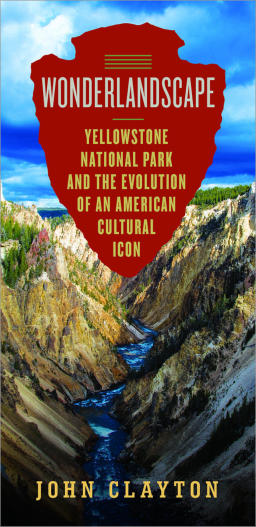
John Clayton:
Wonderlandscape focuses on
why Yellowstone is famous
and how that has changed
over the years.
